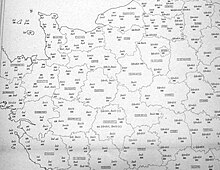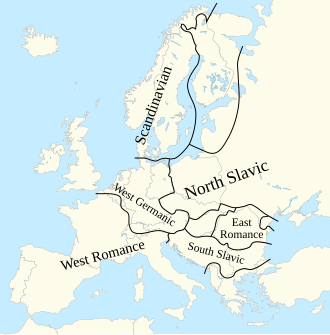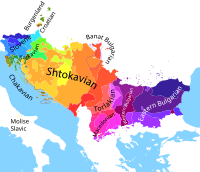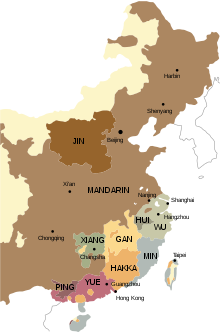Dialect continuum
This article needs additional citations for verification. (May 2016) |
| Part of a series on |
| Linguistics |
|---|
|
|
A dialect continuum or dialect chain is a series of language varieties spoken across some geographical area such that neighboring varieties are mutually intelligible, but the differences accumulate over distance so that widely separated varieties may not be.[1] This is a typical occurrence with widely spread languages and language families around the world, when these languages did not spread recently. Some prominent examples include the Indo-Aryan languages across large parts of India, varieties of Arabic across north Africa and southwest Asia, the Turkic languages, the Chinese languages or dialects, and parts of the Romance, Germanic and Slavic families in Europe. Terms used in older literature include dialect area (Leonard Bloomfield)[2] and L-complex (Charles F. Hockett).[3]
Dialect continua typically occur in long-settled agrarian populations, as innovations spread from their various points of origin as waves. In this situation, hierarchical classifications of varieties are impractical. Instead, dialectologists map variation of various language features across a dialect continuum, drawing lines called isoglosses between areas that differ with respect to some feature.[4]
A variety within a dialect continuum may be developed and codified as a standard language, and then serve as an authority for part of the continuum, e.g. within a particular political unit or geographical area. Since the early 20th century, the increasing dominance of
Dialect geography

Dialectologists record variation across a dialect continuum using maps of various features collected in a
Secondary studies may include interpretive maps, showing the areal distribution of various variants.[6] A common tool in these maps is an isogloss, a line separating areas where different variants of a particular feature predominate.[7]
In a dialect continuum, isoglosses for different features are typically spread out, reflecting the gradual transition between varieties.[8] A bundle of coinciding isoglosses indicates a stronger dialect boundary, as might occur at geographical obstacles or long-standing political boundaries.[9] In other cases, intersecting isoglosses and more complex patterns are found.[10]
Relationship with standard varieties

Standard varieties may be developed and codified at one or more locations in a continuum until they have independent cultural status (autonomy), a process the German linguist Heinz Kloss called ausbau. Speakers of local varieties typically read and write a related standard variety, use it for official purposes, hear it on radio and television, and consider it the standard form of their speech, so that any standardizing changes in their speech are towards that variety. In such cases the local variety is said to be dependent on, or heteronomous with respect to, the standard variety.[12]
A standard variety together with its dependent varieties is commonly considered a "language", with the dependent varieties called "dialects" of the language, even if the standard is mutually intelligible with another standard from the same continuum.
The choice of standard is often determined by a political boundary, which may cut across a dialect continuum. As a result, speakers on either side of the boundary may use almost identical varieties, but treat them as dependent on different standards, and thus part of different "languages".[17] The various local dialects then tend to be leveled towards their respective standard varieties, disrupting the previous dialect continuum.[18] Examples include the boundaries between Dutch and German, between Czech, Slovak and Polish, and between Belarusian and Ukrainian.[19][20]
The choice may be a matter of national, regional or religious identity, and may be controversial. Examples of controversies are regions such as the disputed territory of
During the time of the former
Europe

Europe provides several examples of dialect continua, the largest of which involve the
The Romance area spanned much of the territory of the
The Slavic area was in turn split by the Hungarian conquest of the Carpathian Basin in the 9th and 10th centuries.
Germanic languages

North Germanic continuum
The Norwegian, Danish and Swedish dialects comprise a classic example of a dialect continuum, encompassing Norway, Denmark, Sweden and coastal parts of Finland. The Continental North Germanic standard languages (Norwegian, Danish and Swedish) are close enough and intelligible enough for some to consider them to be dialects of the same language, but the Insular ones (Faroese and Icelandic) are not immediately intelligible to the other North Germanic speakers.
Continental West Germanic continuum
Historically, the Dutch, Frisian, Low Saxon and High German dialects formed a canonical dialect continuum, which has been gradually falling apart since the Late Middle Ages due to the pressures of modern education, standard languages, migration and weakening knowledge of the dialects.[27]
The transition from German dialects to Dutch variants followed two basic routes:
- From Central German to Southeastern Dutch (Limburgish) in the so-called Rhenish fan, an area corresponding largely to the modern Niederrhein in which gradual but geographically compact changes took place.[28]
- From Low SaxonStandard Dutch and, after the collapse of the Hanseatic League, from Standard German which greatly influenced the vocabularies of these border dialects.[27]
Though the internal dialect continua of both Dutch and German remain largely intact, the continuum which historically connected the Dutch, Frisian and German languages has largely disintegrated. Fragmentary areas of the Dutch-German border in which language change is more gradual than in other sections or a higher degree of mutual intelligibility is present still exist, such as the Aachen-Kerkrade area, but the historical chain in which dialects were only divided by minor isoglosses and negligible differences in vocabulary has seen a rapid and ever-increasing decline since the 1850s.[27]
Anglic continuum
The
Romance languages
Western Romance continuum

The western continuum of
Focusing instead on the local Romance lects that pre-existed the establishment of national or regional standard languages, all evidence and principles point to Romania continua as having been, and to varying extents in some areas still being, what
In recent centuries, the intermediate dialects between the major Romance languages have been moving toward extinction, as their speakers have switched to varieties closer to the more prestigious national standards. That has been most notable in France,[citation needed] owing to the French government's refusal to recognise minority languages,[32] but it has occurred to some extent in all Western Romance speaking countries. Language change has also threatened the survival of stateless languages with existing literary standards, such as Occitan.
The Romance languages of Italy are a less arguable example of a dialect continuum. For many decades since Italy's unification, the attitude of the French government towards the ethnolinguistic minorities was copied by the Italian government.[33][34]
Eastern Romance continuum
The eastern Romance continuum is dominated by Romanian. Outside Romania and Moldova, across the other south-east European countries, various Romanian language groups are to be found: pockets of various Romanian and Aromanian subgroups survive throughout Bulgaria, Serbia, North Macedonia, Greece, Albania and Croatia (in Istria).
Slavic languages
Conventionally, on the basis of extralinguistic features (such as writing systems or the former western frontier of the Soviet Union), the North Slavic continuum is split into East and West Slavic continua. From the perspective of linguistic features alone, only two Slavic (dialect) continua can be distinguished, namely, North and South.[35][36][37]
North Slavic continuum
The North Slavic continuum covers the East Slavic and West Slavic languages. East Slavic includes Russian, Belarusian, Rusyn and Ukrainian; West Slavic languages of Czech, Polish, Slovak, Silesian, Kashubian, and Upper and Lower Sorbian.
South Slavic continuum

All South Slavic languages form a dialect continuum. Therefore,
The barrier between East South Slavic and West South Slavic is historical and natural, caused primarily by a one-time geographical distance between speakers. The two varieties started diverging early on (c. 11th century CE) and evolved separately ever since without major mutual influence, as evidenced by distinguishable
Uralic languages
The other major language family in Europe besides Indo-European are the
Goidelic continuum
The
.The current Goidelic speaking areas of Ireland are also separated by extinct dialects but remain mutually intelligible.
Middle East
Arabic
The difference between the written standard and the vernaculars is apparent also in the written language, and children have to be taught Modern Standard Arabic in school to be able to read it.
Aramaic
All
Kurdish
The
Persian
The
Turkic
There are also Gagauz speakers in Moldavia and Urum speakers in Georgia.
The Turkic continuum makes internal genetic classification of the languages problematic.
Indo-Aryan languages
Many of the
Chinese

Chinese consists of hundreds of mutually unintelligible local varieties.[60][61] The differences are similar to those within the
Chinese dialectologists have divided the local varieties into a number of dialect groups, largely based on phonological developments in comparison with Middle Chinese.[64] Most of these groups are found in the rugged terrain of the southeast, reflecting the greater variation in this area, particularly in Fujian.[65][66] Each of these groups contains numerous mutually unintelligible varieties.[60] Moreover, in many cases the transitions between groups are smooth, as a result of centuries of interaction and multilingualism.[67]
The boundaries between the northern Mandarin area and the central groups, Wu, Gan and Xiang, are particularly weak, due to the steady flow of northern features into these areas.[68][69] Transitional varieties between the Wu, Gan and Mandarin groups have been variously classified, with some scholars assigning them to a separate Hui group.[70][71] The boundaries between Gan, Hakka and Min are similarly indistinct.[72][73] Pinghua and Yue form a dialect continuum (excluding urban enclaves of Cantonese).[74] There are sharper boundaries resulting from more recent expansion between Hakka and Yue, and between Southwestern Mandarin and Yue, but even here there has been considerable convergence in contact areas.[75]
Cree and Ojibwa
- Plains Cree (y-dialect)
- Woods Cree or Woods/Rocky Cree (ð-dialect)
- Swampy Cree (n-dialect)
- Eastern Swampy Cree
- Western Swampy Cree
- Moose Cree (l-dialect)
- East Cree or James Bay Cree (y-dialect)
- Northern East Cree
- Southern East Cree
- Atikamekw (r-dialect)
- Western Montagnais (l-dialect)
- Innu-aimunor Eastern Montagnais (n-dialect)
- Naskapi (y-dialect)
Various Cree languages are used as languages of instruction and taught as subjects: Plains Cree, Eastern Cree, Montagnais, etc. Mutual intelligibility between some dialects can be low. There is no accepted standard dialect.[76][77][78]
Ojibwa (Chippewa) is a group of closely related Algonquian languages in Canada, which is distributed from British Columbia to Quebec, and the United States, distributed from Montana to Michigan, with diaspora communities in Kansas and Oklahoma. With Cree, the Ojibwe dialect continuum forms its own continuum, but the Oji-Cree language of this continuum joins the Cree–Montagnais–Naskapi dialect continuum through Swampy Cree. The Ojibwe continuum has 70,606 speakers. Roughly from northwest to southeast, it has these dialects:
- Ojibwa-Ottawa
- Algonquin
- Oji-Cree (Northern Ojibwa) or Severn
- Ojibwa
- Western Ojibwa or Saulteaux
- Chippewa (Southwestern Ojibwa)
- Northwestern Ojibwa
- Central Ojibwa or Nipissing
- Eastern Ojibwa or Mississauga
- Ottawa (Southeastern Ojibwa)
- Potawatomi
Unlike the Cree–Montagnais–Naskapi dialect continuum, with distinct n/y/l/r/ð dialect characteristics and noticeable west–east k/č(ch) axis, the Ojibwe continuum is marked with
See also
- A language is a dialect with an army and navy (an aphorism spread among linguists)
- Dialect, including the classification units "dialect cluster", "language cluster" and "dialect group"
- Dialect levelling
- Dialectometry
- Diasystem
- Diglossia
- Koine language
- Language secessionism
- Linkage (linguistics)
- Macrolanguage
- Post-creole speech continuum
- Ring species, an analogous concept in ecology
Notes
- ^ Carpathian Ruthenia is mistakenly excluded from North Slavic on the map, even though Rusyn, an East Slavic dialect group on the transition to West Slavic, is spoken there.
- ^ In this context, "A group of related dialects of Low German, spoken in northern Germany and parts of the Netherlands, formerly also in Denmark." (Definition from Wiktionary)
References
- ISBN 978-1-405-15296-9.
- ^ Bloomfield, Leonard (1935). Language. London: George Allen & Unwin. p. 51.
- ^ Hockett, Charles F. (1958). A Course in Modern Linguistics. New York: Macmillan. pp. 324–325.
- ISBN 978-0-521-59646-6.
- ^ Chambers & Trudgill (1998), pp. 15–17.
- ^ a b Chambers & Trudgill (1998), p. 25.
- ^ Chambers & Trudgill (1998), p. 27.
- ^ Chambers & Trudgill (1998), pp. 93–94.
- ^ Chambers & Trudgill (1998), pp. 94–95.
- ^ Chambers & Trudgill (1998), pp. 91–93.
- ^ Chambers & Trudgill (1998), p. 10.
- ^ Chambers & Trudgill (1998), pp. 9–12.
- ISBN 978-3-11-080537-6.
- ^ Chambers & Trudgill (1998), p. 11.
- ^ Chambers & Trudgill (1998), pp. 3–4.
- ^ Chambers & Trudgill (1998), p. 4.
- ^ Chambers & Trudgill (1998), p. 9.
- ISBN 978-3-11-022025-4. p. 501.
- ^ Woolhiser (2011), pp. 507, 516–517.
- ISBN 978-82-7661-078-9. p. 152.
- . pp. 173–174.
- ^ Chambers & Trudgill (1998), p. 6.
- ^ W. Heeringa: Measuring Dialect Pronunciation Differences using Levenshtein Distance. University of Groningen, 2009, pp. 232–234.
- ^ Peter Wiesinger: Die Einteilung der deutschen Dialekte. In: Werner Besch, Ulrich Knoop, Wolfgang Putschke, Herbert Ernst Wiegand (Hrsg.): Dialektologie. Ein Handbuch zur deutschen und allgemeinen Dialektforschung, 2. Halbband. de Gruyter, Berlin / New York 1983, ISBN 3-11-009571-8, pp. 807–900.
- ISBN 978-3-423-03025-0, pp. 230.
- ^ C. Giesbers: Dialecten op de grens van twee talen. Radboud Universiteit Nijmegen, 2008, pp. 233.
- ^ ISBN 978-90-232-4329-8. p. 54.
- ^ Chambers & Trudgill (1998), p. 92.
- ISBN 978-0-415-05768-4. p. 11.
- ISBN 978-3-515-09372-9.
- ^ Gooskens & Heeringa (2004)
- ^ "Le Sénat dit non à la Charte européenne des langues régionales". Franceinfo. 27 October 2015. Archived from the original on 3 December 2023.
- ^ "Italy : 5.1 General legislation : 5.1.9 Language laws". Compendium of Cultural Policies and Trends in Europe. Council of Europe/ERICarts. 18 September 2013. Archived from the original on 2 March 2014. Retrieved 26 February 2014.
- ^ Cerruti, Massimo (26 January 2011). "Italiano e dialetto oggi in Italia". Treccani. Archived from the original on 23 October 2022.
- ^ Peter Trudgill. 2003. A Glossary of Sociolinguistics. Oxford: Oxford University Press, pp 36, 95-96, 124-125.
- ^ [1]Tomasz Kamusella. 2017. Map A4, Dialect Continua in Central Europe, 1910 (p 94) and Map A5, Dialect Continua in Central Europe, 2009 (p 95). In: Tomasz Kamusella, Motoki Nomachi, and Catherine Gibson, eds. 2017. Central Europe Through the Lens of Language and Politics: On the Sample Maps from the Atlas of Language Politics in Modern Central Europe (Ser: Slavic Eurasia Papers, Vol 10). Sapporo, Japan: Slavic-Eurasian Research Center, Hokkaido University.
- ^ Kamusella, Tomasz (2005). "The Triple Division of the Slavic Languages: A Linguistic Finding, a Product of Politics, or an Accident?" (Working Paper). Vienna: Institut für die Wissenschaften vom Menschen. 2005/1.
- OCLC 300458429.
- OCLC 46734277.
- OCLC 47186443.
- ISSN 0044-2356.
- (PDF) from the original on 1 June 2012. Retrieved 9 March 2017.
- OCLC 51961066.
- OL 15295665W.
- (PDF) from the original on 1 June 2012. Retrieved 15 May 2019.
- OCLC 243829127.
- S2CID 150383965.
lexical differences between the ethnic variants are extremely limited, even when compared with those between closely related Slavic languages (such as standard Czech and Slovak, Bulgarian and Macedonian), and grammatical differences are even less pronounced. More importantly, complete understanding between the ethnic variants of the standard language makes translation and second language teaching impossible", leading Šipka "to consider it a pluricentric standard language
- OCLC 55754615.
- ISSN 0080-2557.
- ISBN 978-0-415-01035-1.
- ISBN 978-0-901519-90-0.
- ^ McLeod, Wilson (2017). "Dialectal diversity in contemporary Gaelic: perceptions, discourses and responses" (PDF). University of Aberdeen. Archived from the original (PDF) on 14 February 2022.
- ^ Wahrmund, Adolf (1898). Praktisches Handbuch der neu-arabischen Sprache ... Vol. 1-2 of Praktisches Handbuch der neu-arabischen Sprache (3 ed.). J. Ricker. Retrieved 6 July 2011.
- ISBN 978-0-415-05767-7.
- JSTOR 25608409.
- S2CID 165973597.
- S2CID 216353456.
- OCLC 53984252.
- ISBN 978-1-4020-1298-3.
- ^ ISBN 978-0-7007-1129-1. p. 72.
- PMID 16024359.
- ISBN 978-0-521-29653-3.
- ^ Norman (1988), pp. 2–3.
- ISBN 978-3-11-021914-2.
- ISBN 978-0-691-01468-5.
- ^ Norman (1988), pp. 183–190.
- JSTOR 23756757. p 299.
- ^ Norman (1988), pp. 190, 206–207.
- ISBN 978-3-11-080537-6. p. 12.
- ISBN 978-3-89586-629-6.
- ^ Norman (1988), p. 206.
- ^ Norman (1988), p. 241.
- ^ Norman (2003), p. 80.
- ISBN 978-0-19-872379-0. p. 162.
- ^ Halliday (1968), pp. 11–12.
- ^ "LINGUIST List 6.744: Cree dialects". www.linguistlist.org. 29 May 1995.
- ^ "Canada".
- ^ "Cree Language and the Cree Indian Tribe (Iyiniwok, Eenou, Eeyou, Iynu, Kenistenoag)". www.native-languages.org. Archived from the original on 4 April 2011. Retrieved 10 September 2008.
